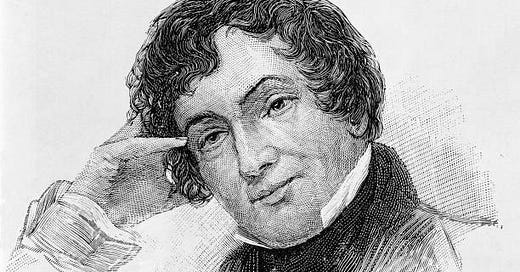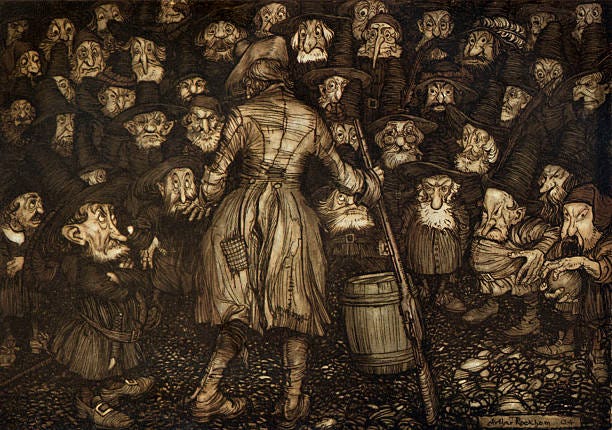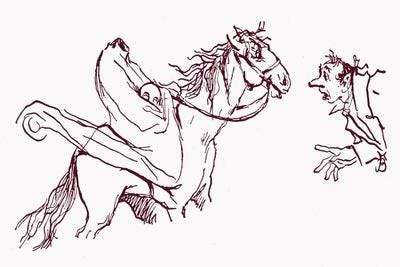Dear Republic,
I first came across Stephen Akey in a piece in which he outed himself as a “failure,” and he has been one of my very favorite failures since then — a consistently mellifluous, elegant, and heartfelt writer who deserves (probably more than Washington Irving, to be honest) to be better known.
Please like, submit, donate, repost, et al, and help to make The Republic of Letters a really special crowd-source publication. We’ll gradually get more incendiary and hot button-y, but I really couldn’t be happier with this first batch of classy submissions about a whole secret garden of forgotten and unjustly-neglected writers. The next contests are “What Is The Best Case Outcome For The University?” due April 7 and “What Has Happened To Literary Men?” due April 13 (with submissions sent to republic.of.letters.substack@gmail.com).
-The Editor
DEAR, DREAR WASHINGTON IRVING
In surveys of historically underestimated writers that appear occasionally in publications like the Time Literary Supplement and, now, The Republic of Letters, I don’t recall ever seeing the name Washington Irving. There’s a reason for that: he’s not that good. Important though he was in the establishment of a national literature, it’s hard to get past his labored humor and fusty prose. I’ve tried. My Barnes & Noble Classics edition of The Legend of Sleepy Hollow and Other Writings contains an awful lot of Other Writings that refuse to yield anything like the pleasures to be had from the title tale and “Rip Van Winkle.” Maybe I'm looking in the wrong places, but my fitful efforts to discover overlooked gems have only turned up painfully unfunny specimens of wit such as this headnote to Salmagundi No. VII: “LETTER FROM MUSTAPHA RUB-A-DUB KELI KHAN, TO ASEM HACCHEM, PRINCIPAL SLAVE-DRIVER TO HIS HIGHNESS THE BASHAW OF TRIPOLI.”
There doesn’t seem to be any way past the evident truth that the only works of Irving to have survived are “The Legend of Sleepy Hollow’” and “Rip Van Winkle.” And really, how good could these former staples of the high school English curriculum possibly be? Well, I’ll tell you: they’re spectacular — haunting, disturbing, and uncanny fever dreams of early American displacement and alienation. On these — and only on these — two occasions, Irving, the cheerful, proficient purveyor of harmless gentility, transformed himself into a sort of proleptic Franz Kafka of the Hudson Valley. Readers have always been charmed by these two waggish tales. Maybe they ought to be appalled.
Notwithstanding its apparent good humor and heartiness, most readers, I think, intuit some sense of mythopoeic power in the story of Rip Van Winkle’s strange twenty-year slumber and stranger awakening. That story has become part of our folklore for good reason, and if I could put my finger on that reason, it wouldn’t be folklore anymore. Nevertheless, the story queasily conveys the sense that time is not our element; that we are all, like Rip, washed up on a temporal shore of incomprehension; that we have awoken to a world hurrying us to obsolescence; and that our cognitive equipment for making sense of our incomprehensible world is as inadequate to the task as Rip’s rusty, worm-eaten flintlock. And then there’s the vision of the weird, silent mountain people in their jerkins and doublets, solemnly playing at nine-pins and commanding Rip to drink the flagons: an allegory with no referent, like an anxiety dream whose iron illogic admits no question. This dream, this vision, indeed the tale itself, means everything and nothing all at once. That’s a lot to pack in — or leave out — of any short story. The editor of my edition explains “Rip Van Winkle” as a parable of “pre-history for the new republic free of the emotional scars of its having severed ties with England,” but what makes the story so weirdly modern and insinuating is that it remains, fundamentally, inexplicable.
A similar sense of exclusion governs “The Legend of Sleepy Hollow.” Ichabod Crane, the wretched, ungainly schoolmaster, will never win the heart of the village beauty Katrina Van Tassel. She’s a Dutch heiress; he’s a nobody. And if it takes some bullying and harassment to ensure that social boundaries remain intact, some slight infliction of trauma on the hapless Ichabod ought to do the trick. And yet the elderly Ichabod, who appears as an unnamed interlocutor in a postscript, is manifestly unamused by the umpteenth retelling of the tale: He “maintained a grave and rather severe face throughout; now and then folding his arms, inclining his head, and looking down upon the floor.” Kafka’s tales are hideously funny, but Joseph K. doesn’t find his ordeals especially amusing either.
I could go on explaining away the dark magic of these two loaded stories, but there’s a better way to appreciate this underappreciated and misunderstood writer. Go to Grand Central Terminal. Buy a ticket for the commuter train to Philipse Manor. At Philipse Manor, exit the train and walk up the steep stairway to Millard Avenue. Proceed through the lovely, moneyed streetscape of this classy Westchester town, bearing northeast until emerging on the fearsome Route 9 at Farrington Avenue. Cross Route 9 very, very carefully to arrive at the entrance to Sleepy Hollow Cemetery. If you have time, you might take a detour to the southern end of the cemetery to visit Irving’s grave, but your destination is elsewhere. Follow the rise and fall of the cemetery (built on a ridge overlooking the Hudson) until you reach a retaining wall with a chain link fence on the eastern perimeter. At the far end of a small rectangular field, you will find a sizeable rip in the fence. Step through. You are now on the trail of the former Croton Aqueduct. A quick turn to the left will take you into Rockefeller State Park. This is, approximately, the place where Ichabod had his encounter with the Headless Horseman: “A small brook glides through it, with just murmur enough to lull one to repose; and the occasional whistle of a quail, or tapping of a woodpecker, is almost the only sound that ever breaks in upon the uniform tranquility.” It’s still pretty much like that, a perfect place to contemplate the beauty and cruelty of the natural and human worlds that Irving perfectly distilled about two hundred years ago in two profoundly disturbing short stories.
It's likely that Irving would have seen “The Legend of Sleepy Hollow” and “Rip Van Winkle” as entirely consistent with the gentle, leisurely, unthreatening satire of his Other Writings. He stands, after all, at the head of the Genteel Tradition in American literature. Am I torturing two relatively harmless tales to fit an interpretive model that privileges desolation and social fracture over harmony and equilibrium? What’s next — Henry Wadsworth Longfellow as the precursor to Allen Ginsberg? William Dean Howells as a secret incendiary, like William S. Burroughs without the drugs and gay sex? No, if only because I think Longfellow and Howells were better writers than Ginsberg and Burroughs. In fact, I could make a pretty good case for Longfellow and Howells as grossly underappreciated themselves,1 dealing as they (sometimes) did with the corrosive effects of American mercantilism and the personal cost of holding to oppositional values. In American writing, you don’t have to look far to find a thematic of personal disillusionment and social toxicity. In fact, disenchantment is more the rule than the exception in literary writing of any sort. It may be playful, it may be funny, it may be rich and beautiful and strange, but a principal business of literature is to rid us of the illusions that impede a proper reckoning with ourselves and the world we have made. That disillusionment is everywhere in literary writing, even in the midst of the Genteel Tradition, where an otherwise mediocre writer about two hundred years ago dreamed up two seemingly innocent tales that plunge us into a vortex of incomprehension and existential disquietude.
Stephen Akey is a memoirist and essayist who lives in Brooklyn, New York. He is the author of Raccoon Love, Culture Fever, and College."
There actually is a Republic of Letters piece to come making exactly this claim about Howells! - The Editor








You used to have to climb over the chainlink fence. I once ripped my pants doing so! However, there has been for some years a sizable rip in the fence, used by hikers taking the same route from the train station. Look for a rectangular field with few or no gravestones, and above a low retaining wall, you'll see the rip in the fence. Step on through.
Thank you for the great tip. I will definitely read the story. It sounds exactly like the overlooked gem I had been looking for.